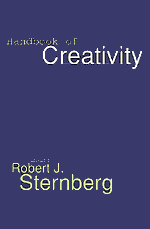Book contents
- Frontmatter
- Contents
- List of Contributors
- Preface
- Handbook of Creativity
- PART I INTRODUCTION
- PART II METHODS FOR STUDYING CREATIVITY
- 3 Psychometric Approaches to the Study of Human Creativity
- 4 Experimental Studies of Creativity
- 5 The Case Study Method and Evolving Systems Approach for Understanding Unique Creative People at Work
- 6 Creativity from a Historiometric Perspective
- PART III ORIGINS OF CREATIVITY
- PART IV CREATIVITY, THE SELF, AND THE ENVIRONMENT
- PART V SPECIAL TOPICS IN CREATIVITY
- PART VI CONCLUSION
- Author Index
- Subject Index
3 - Psychometric Approaches to the Study of Human Creativity
Published online by Cambridge University Press: 05 June 2014
- Frontmatter
- Contents
- List of Contributors
- Preface
- Handbook of Creativity
- PART I INTRODUCTION
- PART II METHODS FOR STUDYING CREATIVITY
- 3 Psychometric Approaches to the Study of Human Creativity
- 4 Experimental Studies of Creativity
- 5 The Case Study Method and Evolving Systems Approach for Understanding Unique Creative People at Work
- 6 Creativity from a Historiometric Perspective
- PART III ORIGINS OF CREATIVITY
- PART IV CREATIVITY, THE SELF, AND THE ENVIRONMENT
- PART V SPECIAL TOPICS IN CREATIVITY
- PART VI CONCLUSION
- Author Index
- Subject Index
Summary
The study of human creativity, although historically extensive, is in the midst of a second golden age as the century comes to a close. Authors and researchers from a variety of backgrounds publish hundreds of articles and books on creativity every year, conferences that cross disciplines frequently include sessions on creativity, and programs for increasing the creative productivity of young people and adults are introduced on a regular basis. And while several distinct approaches are used to examine creative phenomenon, a majority of work dealing with creativity relies on psychometric methods - the direct measurement of creativity and/or its perceived correlates in individuals.
Indeed, practically all current work on creativity is based upon methodologies that either are psychometric in nature or were developed in response to perceived weaknesses of creativity measurement. As such, the psychometric studies of creativity conducted in the past few decades form the foundation of current understandings of creativity. Yet the psychometric approach is significantly more complex and comprehensive than its critics (and many of its proponents) would have us believe, and alternatives to the psychometric approach are wrought with many of the same difficulties posed during the direct measurement of creativity. A thorough review of psychometric techniques for the study of creativity benefits both those individuals attempting to measure creativity and those individuals studying creativity via other techniques.
- Type
- Chapter
- Information
- Handbook of Creativity , pp. 35 - 61Publisher: Cambridge University PressPrint publication year: 1998
- 27
- Cited by



